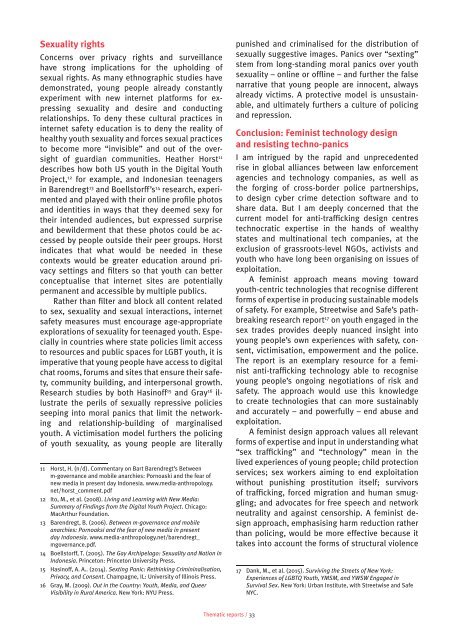Global Information Society Watch 2015
gw2015-full-report
gw2015-full-report
Create successful ePaper yourself
Turn your PDF publications into a flip-book with our unique Google optimized e-Paper software.
Sexuality rights<br />
Concerns over privacy rights and surveillance<br />
have strong implications for the upholding of<br />
sexual rights. As many ethnographic studies have<br />
demonstrated, young people already constantly<br />
experiment with new internet platforms for expressing<br />
sexuality and desire and conducting<br />
relationships. To deny these cultural practices in<br />
internet safety education is to deny the reality of<br />
healthy youth sexuality and forces sexual practices<br />
to become more “invisible” and out of the oversight<br />
of guardian communities. Heather Horst 11<br />
describes how both US youth in the Digital Youth<br />
Project, 12 for example, and Indonesian teenagers<br />
in Barendregt 13 and Boellstorff’s 14 research, experimented<br />
and played with their online profile photos<br />
and identities in ways that they deemed sexy for<br />
their intended audiences, but expressed surprise<br />
and bewilderment that these photos could be accessed<br />
by people outside their peer groups. Horst<br />
indicates that what would be needed in these<br />
contexts would be greater education around privacy<br />
settings and filters so that youth can better<br />
conceptualise that internet sites are potentially<br />
permanent and accessible by multiple publics.<br />
Rather than filter and block all content related<br />
to sex, sexuality and sexual interactions, internet<br />
safety measures must encourage age-appropriate<br />
explorations of sexuality for teenaged youth. Especially<br />
in countries where state policies limit access<br />
to resources and public spaces for LGBT youth, it is<br />
imperative that young people have access to digital<br />
chat rooms, forums and sites that ensure their safety,<br />
community building, and interpersonal growth.<br />
Research studies by both Hasinoff 15 and Gray 16 illustrate<br />
the perils of sexually repressive policies<br />
seeping into moral panics that limit the networking<br />
and relationship-building of marginalised<br />
youth. A victimisation model furthers the policing<br />
of youth sexuality, as young people are literally<br />
11 Horst, H. (n/d). Commentary on Bart Barendregt’s Between<br />
m-governance and mobile anarchies: Pornoaski and the fear of<br />
new media in present day Indonesia. www.media-anthropology.<br />
net/horst_comment.pdf<br />
12 Ito, M., et al. (2008). Living and Learning with New Media:<br />
Summary of Findings from the Digital Youth Project. Chicago:<br />
MacArthur Foundation.<br />
13 Barendregt, B. (2006). Between m-governance and mobile<br />
anarchies: Pornoaksi and the fear of new media in present<br />
day Indonesia. www.media-anthropology.net/barendregt_<br />
mgovernance.pdf.<br />
14 Boellstorff, T. (2005). The Gay Archipelago: Sexuality and Nation in<br />
Indonesia. Princeton: Princeton University Press.<br />
15 Hasinoff, A. A.. (2014). Sexting Panic: Rethinking Crimininalisation,<br />
Privacy, and Consent. Champagne, IL: University of Illinois Press.<br />
16 Gray, M. (2009). Out in the Country: Youth, Media, and Queer<br />
Visibility in Rural America. New York: NYU Press.<br />
punished and criminalised for the distribution of<br />
sexually suggestive images. Panics over “sexting”<br />
stem from long-standing moral panics over youth<br />
sexuality – online or offline – and further the false<br />
narrative that young people are innocent, always<br />
already victims. A protective model is unsustainable,<br />
and ultimately furthers a culture of policing<br />
and repression.<br />
Conclusion: Feminist technology design<br />
and resisting techno-panics<br />
I am intrigued by the rapid and unprecedented<br />
rise in global alliances between law enforcement<br />
agencies and technology companies, as well as<br />
the forging of cross-border police partnerships,<br />
to design cyber crime detection software and to<br />
share data. But I am deeply concerned that the<br />
current model for anti-trafficking design centres<br />
technocratic expertise in the hands of wealthy<br />
states and multinational tech companies, at the<br />
exclusion of grassroots-level NGOs, activists and<br />
youth who have long been organising on issues of<br />
exploitation.<br />
A feminist approach means moving toward<br />
youth-centric technologies that recognise different<br />
forms of expertise in producing sustainable models<br />
of safety. For example, Streetwise and Safe’s pathbreaking<br />
research report 17 on youth engaged in the<br />
sex trades provides deeply nuanced insight into<br />
young people’s own experiences with safety, consent,<br />
victimisation, empowerment and the police.<br />
The report is an exemplary resource for a feminist<br />
anti-trafficking technology able to recognise<br />
young people’s ongoing negotiations of risk and<br />
safety. The approach would use this knowledge<br />
to create technologies that can more sustainably<br />
and accurately – and powerfully – end abuse and<br />
exploitation.<br />
A feminist design approach values all relevant<br />
forms of expertise and input in understanding what<br />
“sex trafficking” and “technology” mean in the<br />
lived experiences of young people; child protection<br />
services; sex workers aiming to end exploitation<br />
without punishing prostitution itself; survivors<br />
of trafficking, forced migration and human smuggling;<br />
and advocates for free speech and network<br />
neutrality and against censorship. A feminist design<br />
approach, emphasising harm reduction rather<br />
than policing, would be more effective because it<br />
takes into account the forms of structural violence<br />
17 Dank, M., et al. (<strong>2015</strong>). Surviving the Streets of New York:<br />
Experiences of LGBTQ Youth, YMSM, and YWSW Engaged in<br />
Survival Sex. New York: Urban Institute, with Streetwise and Safe<br />
NYC.<br />
Thematic reports / 33


